10 Major Festivals in Nepal you should not miss
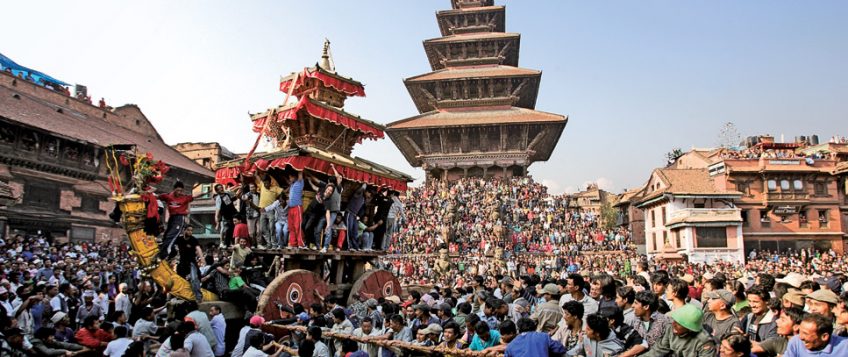
Introduction: A Journey Through Nepal’s Magical Festivals in 2025
Nepal, a country blessed with rich cultural heritage, is home to a variety of major festivals in Nepal celebrated throughout the year. These festivals, steeped in history and spirituality, reflect the diverse traditions of the people of Nepal. 2025 promises to be an extraordinary year for cultural experiences, with a plethora of celebrations that showcase the vibrant and colorful spirit of the nation. From the grand festivities in Kathmandu to the rural rituals in remote villages, these festivals offer a deep connection to the roots of Nepalese society, allowing travelers to witness firsthand the magic that infuses every part of the country.
Overview of Nepal’s Festival Culture
The Significance of Festivals in Nepalese Society
In Nepal, festivals of Nepal are not merely celebratory occasions; they are deeply ingrained in the fabric of society, serving as a means of spiritual reflection, social bonding, and cultural preservation. These events hold religious, seasonal, and historical importance, making them pivotal to the nation’s identity. They create an opportunity for people to come together, reaffirm their faith, and celebrate the values that bind them as a community. Whether it’s honoring gods and goddesses or marking the changing of seasons, festivals of Nepal form the cornerstone of social life in Nepal.
How Festivals Shape Nepal’s Cultural Identity
Festivals of Nepal pictures offer a glimpse into the living manifestation of Nepalese culture. The various ethnic groups that call Nepal home celebrate 20 festival name in Nepal in their own unique ways, contributing to the rich mosaic of rituals, music, dance, and food. These traditions not only preserve the ancient ways of life but also pass down valuable knowledge about nature, religion, and community living. Through festivals, Nepalese people connect with their ancestors, strengthen their bonds with family and friends, and express gratitude for the abundance of life.
Why You Should Experience Nepal’s Festivals in 2025
The Cultural Vibrancy of Nepal in 2025
2025 promises to be an exciting year for cultural enthusiasts seeking to experience 10 major festivals of Nepal in all their glory. With the country’s increasing focus on promoting tourism, the name of festivals in Nepal will be even more accessible to international visitors who want to immerse themselves in the country’s traditions. The festivals of Nepal essay will undoubtedly be a vibrant spectacle of color, music, and joy, offering an unfiltered look at Nepal’s cultural essence.
How Festivals Offer a Deep Dive into Nepalese Traditions
Attending a festival in Nepal is a chance to experience the country’s traditions in their purest form. Festivals in Nepal provide an immersive experience, allowing visitors to participate in rituals, taste traditional foods, and witness performances that are integral to the local culture. They offer a window into the deeply held beliefs and customs of Nepal’s diverse communities, fostering a sense of understanding and appreciation for the country’s heritage.
Dashain Festival: The Grand Celebration of Victory
The Origins and Significance of Dashain
Dashain, the longest and most significant festival in Nepal, celebrates the triumph of good over evil. It is a time when families unite, offering prayers to Goddess Durga for blessings of prosperity, health, and well-being. Dashain’s roots lie in the victory of the goddess Durga over the demon Mahishasura, symbolizing the victory of righteousness.
Key Traditions and Rituals of Dashain
The central rituals of Dashain include tika (blessing) ceremonies, where elders place a mixture of yogurt, rice, and vermillion on the foreheads of younger family members. The offering of sacrifices, particularly to animals such as goats and buffalo, is also a key aspect of Dashain’s traditions. Additionally, the air is filled with vibrant celebrations, as people exchange gifts, cook feasts, and engage in traditional dances.
What Makes Dashain the Biggest Festival in Nepal?
Dashain stands out not only due to its size and scale but also its emotional significance. It is a festival that transcends geographical boundaries, uniting families scattered across the country and the globe. Dashain’s emphasis on family bonding and honoring ancestors makes it the biggest festival in Nepal.
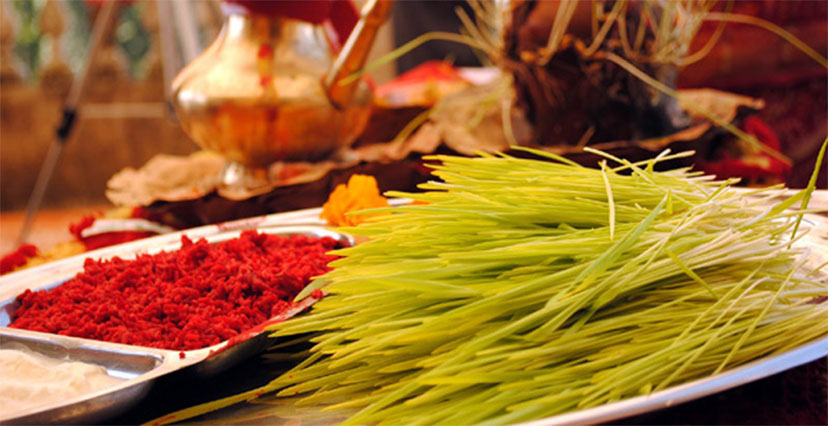
Red tika and jamara are integral parts of the festival celebrations.
The Five Days of Tihar: A Detailed Overview
Each day of Tihar holds its unique significance. The first day is dedicated to honoring crows, while the second honors dogs for their loyalty. The third day is the main celebration, where people worship cows, the symbol of wealth and abundance. The fourth day celebrates the bond between siblings, and the final day is devoted to lighting lamps and welcoming Goddess Laxmi into homes for prosperity.
Celebrating the Bond Between Humans and Animals
One of the most touching aspects of Tihar is the recognition of animals as an integral part of Nepalese life. By honoring animals, Tihar highlights the mutual respect between humans and the natural world, fostering harmony and compassion.
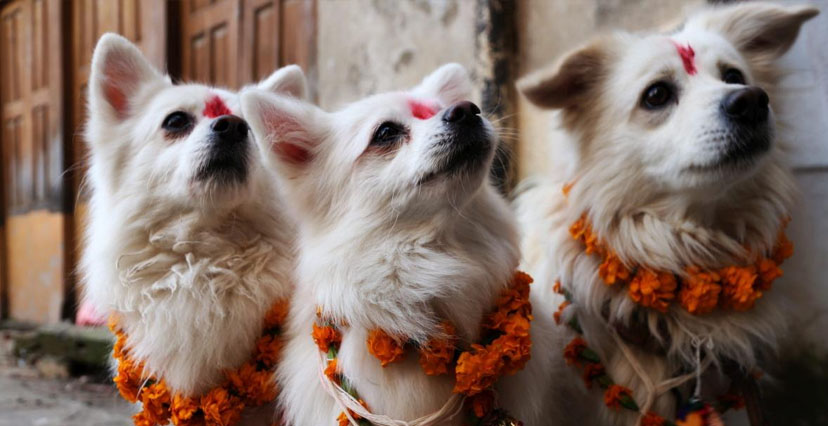
dogs been worshiped during the festival.
Chhath Puja: Honoring the Sun God
The Unique Aspects of Chhath Puja Celebrations
Chhath Puja is a significant festival celebrated by the people of Nepal’s Terai region. It is dedicated to the Sun God, with devotees offering prayers and rituals to seek blessings for health, prosperity, and fertility.
The Rituals Involved in Worshipping the Sun God
The rituals of Chhath Puja involve fasting, bathing in sacred rivers, and offering offerings to the Sun God. The most important aspect of the festival is the offering of “arghya,” where devotees stand in water, with their arms raised toward the setting sun.
Why Chhath Puja is Significant in Nepal’s Terai Region
Chhath Puja is deeply rooted in the cultural and religious traditions of the Terai people. The rituals are a reflection of their respect for nature and their belief in the Sun God’s ability to sustain life.
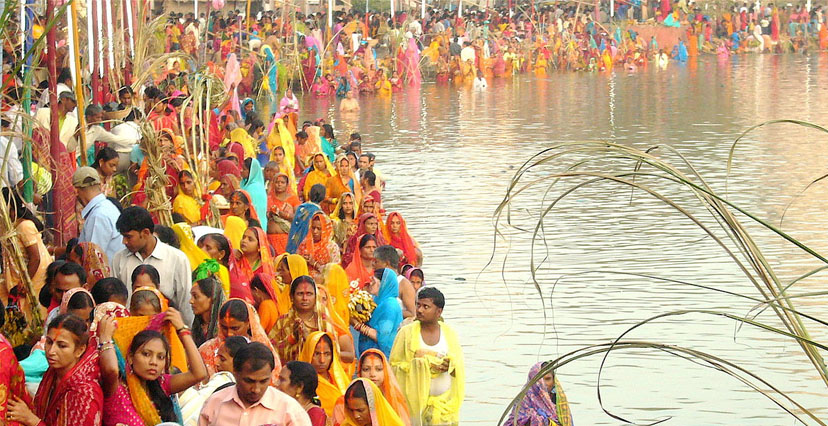
thousands of devotese gather in the bank of the river to celebrate festival
Janai Purnima: A Festival of Sacred Threads
The Rituals and Significance of Janai Purnima
Janai Purnima is a significant Hindu festival where men change their sacred threads, known as “janai.” The festival is also known as the “Raksha Bandhan” festival, symbolizing the bond of protection between brothers and sisters.
How Nepalese Hindus Celebrate Janai Purnima
On Janai Purnima, devotees visit temples to offer prayers and receive blessings from priests. The changing of the sacred thread signifies spiritual renewal and the reaffirmation of one’s faith.
The Role of Sacred Threads in the Festival’s Traditions
The sacred thread represents purity, spirituality, and the sacred bond between individuals and their deity. During Janai Purnima, it is renewed as a mark of strength and connection to higher spiritual realms.
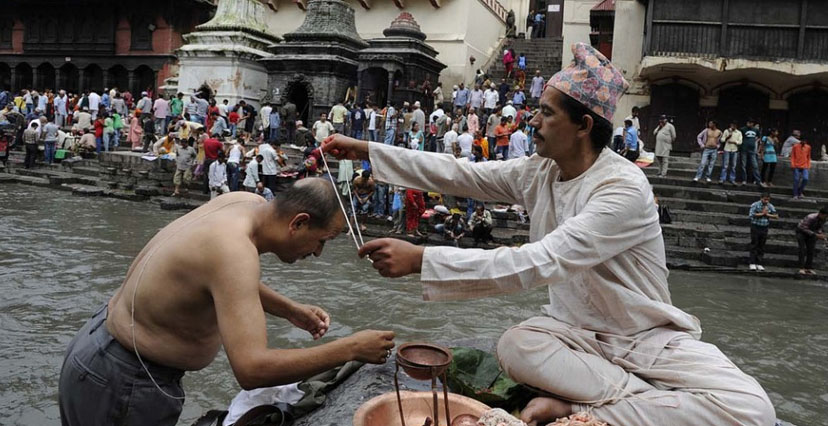
Hindu man receiving the janai (a sacred thread) from the Guru, in the bank of the holi river.
Naag Panchami
Naag Panchami is a traditional Hindu festival dedicated to worshiping Nāgas (serpent deities), observed on the fifth day of the bright half of the lunar month of Shrawan (July/August). It is celebrated in Nepal and parts of India with great devotion.
Significance:
- Symbol of Protection: Naags are revered as protectors of water sources and guardians of wealth.
- Cultural Importance: It highlights the harmony between humans and nature, particularly with snakes.
- Mythological Roots: The festival is linked to stories from Hindu epics like the Mahabharata and Puranas.
How It’s Celebrated:
- Offerings: Devotees offer milk, flowers, rice, and vermilion to snake idols or images of Naags.
- Sacred Places: People visit shrines like Naag Pokhari in Kathmandu or other serpent shrines.
- No Digging: It is customary to avoid digging the ground on this day to prevent harming snakes.
- Rituals: Homes and temples are adorned with Naag posters, and prayers are performed for protection and blessings.
In Nepal, this festival holds a special place, blending spirituality with ecological respect, reminding everyone of the importance of coexistence.
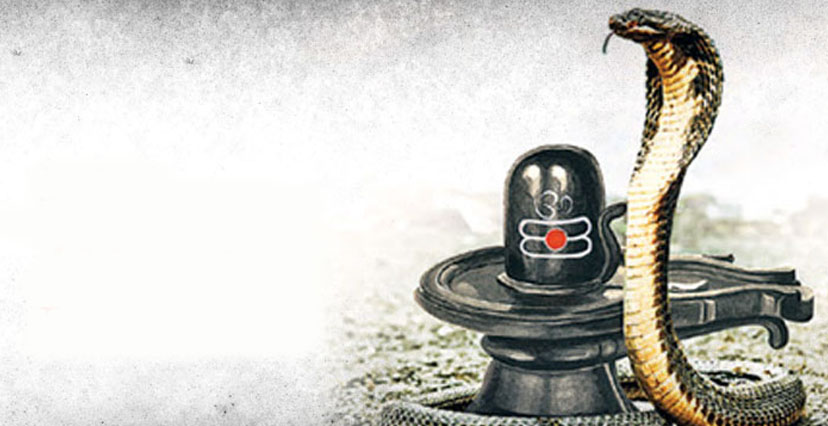
Naag Panchami celebrations
Krishna Janmashtami
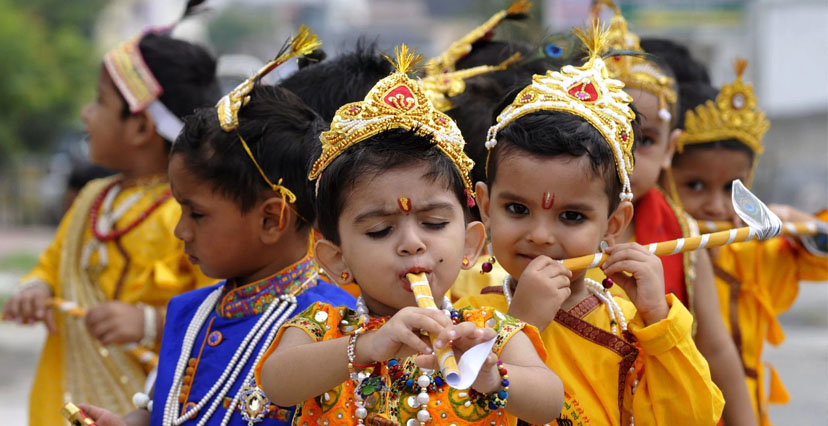
young krishna’s during the festival celebrations.
Gai Jatra: The Festival of Cows and Remembrance
The Tradition of Gai Jatra: Honoring Departed Souls
Gai Jatra is a unique festival that honors the departed souls of the loved ones. The festival’s name translates to “Cow Festival,” as cows are considered sacred in Hinduism and believed to guide the souls to the afterlife.
The Role of Processions and Performances
During Gai Jatra, people dress in traditional attire, and the streets are filled with lively processions. Performances, dances, and skits are held to entertain the participants and bring a sense of joy to the mourning process.
Unique Traditions of Gai Jatra Celebrations in Kathmandu
In Kathmandu, Gai Jatra is celebrated with an air of both reverence and lightheartedness. The festival represents a unique blend of remembrance and festivity, helping families cope with the loss of loved ones while keeping spirits high.
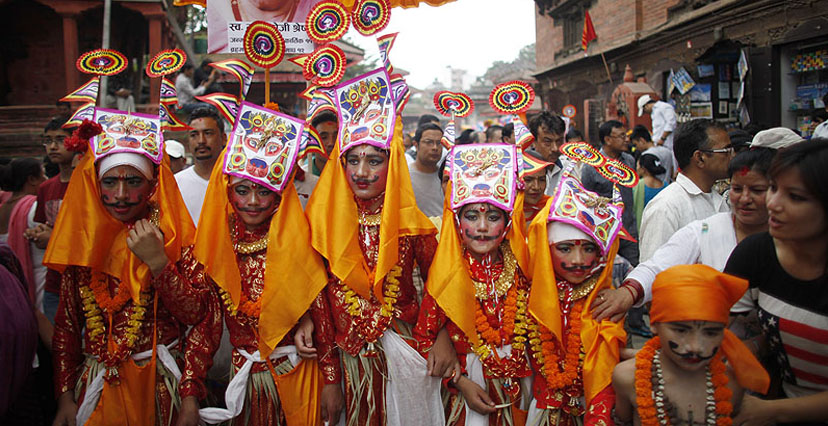
A procession of young family members held in honor of loved ones who passed away in previous years.
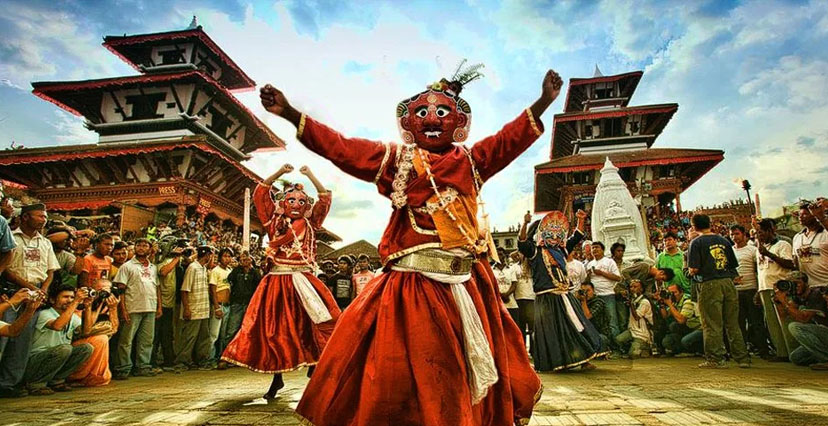
dance of Indra at Durbar Square.
Maghe Sankranti: Welcoming the Sun’s Journey
The Astronomical Significance of Maghe Sankranti
Maghe Sankranti marks the transition of the sun into Capricorn and signifies the arrival of longer days. It is considered an auspicious time for beginning new ventures and is celebrated with great enthusiasm.
How Maghe Sankranti Marks the Beginning of the Harvest Season
Maghe Sankranti is linked to the harvest season, marking the time when farmers begin to reap the fruits of their labor. People celebrate by offering prayers to the Sun God and preparing traditional foods.
The Festive Foods and Rituals During Maghe Sankranti
During Maghe Sankranti, people prepare a variety of traditional foods such as sesame seeds, molasses, and yam. These foods are shared among families and communities as a symbol of abundance and gratitude.
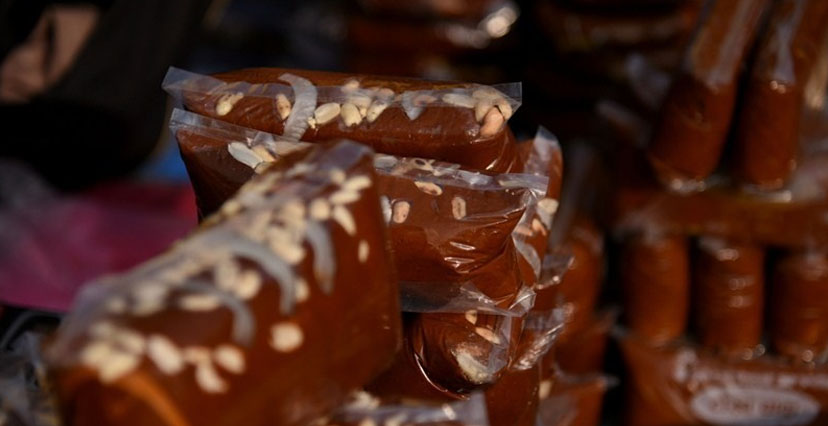
one of the delicacies called Chaku eaten during Maghe sakranti.
Ghode Jatra: A Horse Race Festival in the Heart of Kathmandu
The History of Ghode Jatra and Its Royal Connections
Ghode Jatra is a historic festival with royal connections, traditionally celebrated in honor of the king. It is a celebration of strength, courage, and the timeless bond between the people and their rulers.
The Thrilling Horse Race and Other Festivities
At the heart of Ghode Jatra is the exhilarating horse race, where horses compete in a fast-paced race through the streets of Kathmandu. The race is accompanied by traditional dances, rituals, and festivities that add to the excitement.
Why Ghode Jatra is a Fascinating Experience for Visitors
Ghode Jatra offers visitors a unique opportunity to witness an ancient royal tradition that has been passed down through the ages. The thrilling atmosphere and historical significance make it an unforgettable experience.
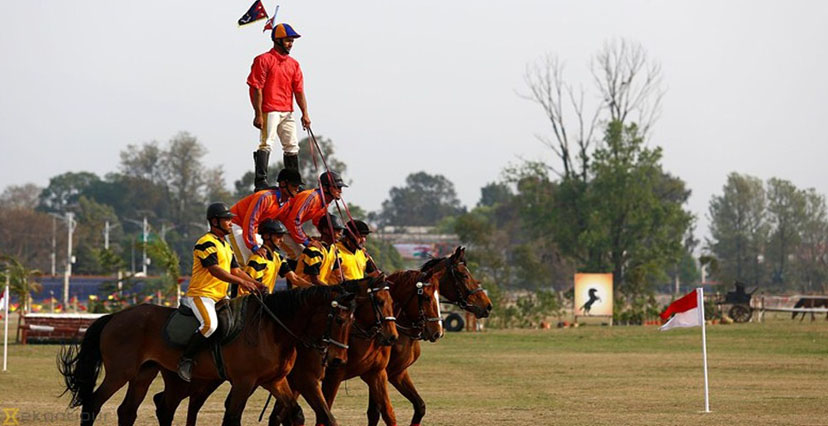
riders showing their skills on the occasion of Ghode Jatra at Tudikhel ground.
Holi Festival: The Festival of Colors and Joy
The Historical Roots of Holi in Nepal
Holi, also known as the Festival of Colors, has its roots in Hindu mythology. It is a celebration of the arrival of spring, symbolizing the victory of good over evil. In Nepal, Holi is celebrated with great enthusiasm, especially in the Terai region, where people gather in large numbers to celebrate the joyous occasion.
How the Streets of Nepal Come Alive During Holi
During Holi, the streets of Nepal are transformed into vibrant canvases of colors. People throw colored powders at one another, sing traditional songs, and dance to the rhythm of folk music. The atmosphere is filled with joy, laughter, and the spirit of unity.
Why Holi is One of the Most Celebrated Festivals in Nepal
Holi is celebrated across Nepal by people of all ages, making it one of the most inclusive and widely anticipated 10 festival name of Nepal. The infectious energy and sense of community make it a favorite among both locals and tourists alike.
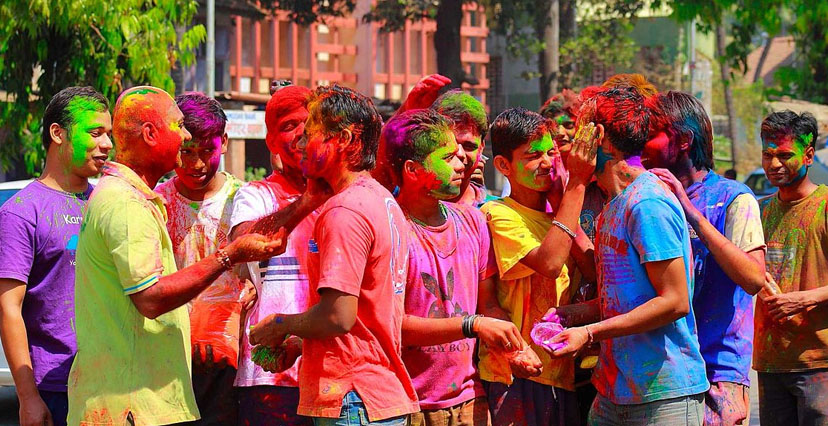
enjoying with colors
Maha Shivaratri: A Night of Devotion and Celebration
The Spiritual Meaning of Maha Shivaratri
Maha Shivaratri is dedicated to Lord Shiva, one of the principal deities of Hinduism. It is a night-long vigil where devotees engage in fasting, chanting mantras, and worshipping Shiva’s idol. The festival is believed to bring spiritual renewal and freedom from sins.
Devotees’ Pilgrimages and Night Vigils
Pilgrims from all over Nepal travel to the famous Pashupatinath Temple in Kathmandu to witness the night-long ceremonies and participate in the sacred rituals. Thousands of sadhus (holy men) gather, adding to the mystical atmosphere of the event.
Key Events and Rituals During Maha Shivaratri
The night of Maha Shivaratri is filled with prayers, the offering of milk and honey, and the lighting of lamps to honor Lord Shiva. Devotees stay awake the entire night, believing it will bring them divine blessings.
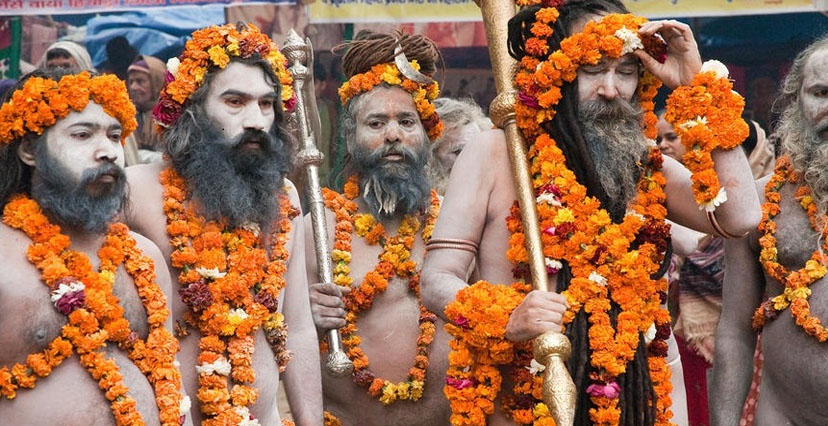
Sadhus devoting themselves to lord Shiva.
Teej Festival: The Festival of Women’s Empowerment
The Symbolism of Teej and the Celebration of Womanhood
Teej is a celebration of womanhood and devotion, particularly for married women. It symbolizes the strength of women and their devotion to family and spiritual welfare.
How Women Celebrate Teej with Fasting and Dancing
Women participate in Teej with fasting, prayers, and dancing. The dances are accompanied by traditional songs, and women often wear beautiful red saris and adorn themselves with intricate jewelry.
The Spiritual Significance of Teej for Married Women
Teej holds great spiritual significance for married women, who believe that fasting and worshiping during this festival will ensure the longevity and health of their husbands.
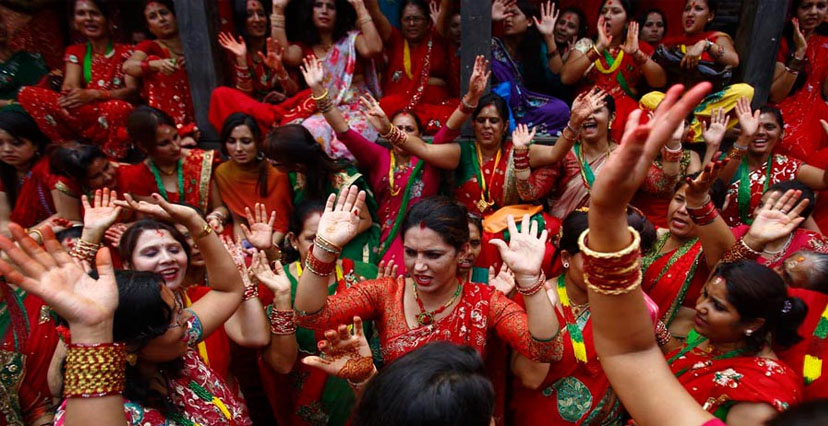
Hindu womens celebrating Teej and devoting themselves to lord Shiva.
Buddha Jayanti: Honoring the Birth of Lord Buddha
The Sacred Significance of Buddha Jayanti
Buddha Jayanti marks the birth, enlightenment, and death anniversary of Siddhartha Gautama, the founder of Buddhism. It is one of the most revered celebrations in Nepal, particularly in the Kathmandu Valley, where large Buddhist communities gather to commemorate Buddha’s teachings and wisdom.
Celebrating Buddha’s Enlightenment in Nepal
The day is marked by prayers, meditation, and offerings at Buddhist stupas and monasteries. Pilgrims walk around the Boudhanath Stupa, chanting mantras and paying homage to Lord Buddha.
Unique Rituals During Buddha Jayanti Celebrations
During Buddha Jayanti, devotees participate in a range of rituals, such as lighting butter lamps, making offerings, and engaging in prayer walks. The day is an embodiment of peace and introspection.
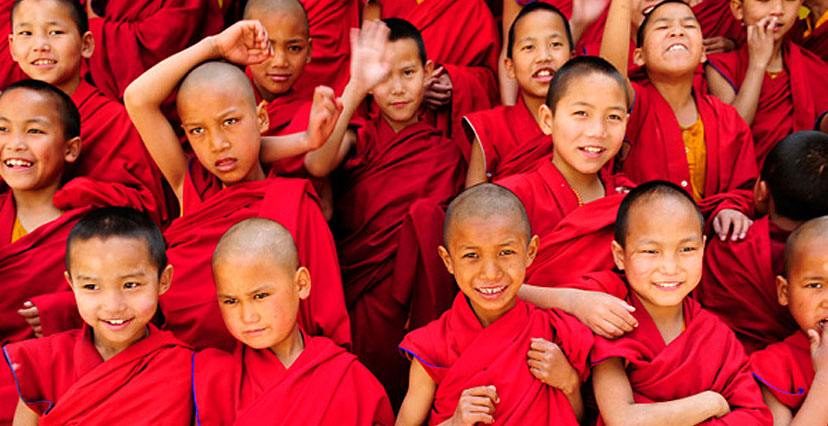
young monks celebrating Buddha Purnima
Kumari Jatra: A Festival Honoring Nepal’s Living Goddess
The Role of the Kumari in Nepalese Culture
The Kumari, the living goddess of Kathmandu, holds a revered position in Nepalese culture. She is believed to embody the divine feminine energy, and her role is celebrated during the Kumari Jatra.
The Spectacular Celebrations of Kumari Jatra
During Kumari Jatra, the Living Goddess is paraded through the streets of Kathmandu in a beautifully decorated chariot. The procession is accompanied by traditional music, dances, and prayers.
The Cultural Significance of the Living Goddess in Kathmandu
The Kumari Jatra represents the importance of the divine feminine in Nepalese culture. It is a celebration of both devotion and cultural continuity, reinforcing the spiritual connection between the people and their heritage.
Lhosar Festival: Celebrating Nepal’s New Year Traditions
How Lhosar Marks the Start of a New Year for Nepalese Communities
Lhosar marks the start of the New Year for various ethnic communities in Nepal. It is a time for reflection, renewal, and celebration of family, unity, and prosperity.
The Cultural and Family Traditions During Lhosar Celebrations
Lhosar is a time for families to come together, exchange gifts, and celebrate their shared cultural heritage. The festivities include traditional music, dance, and delicious foods that symbolize the hopes for a prosperous year ahead.
The Festivities and Food Associated with Lhosar
Lhosar is a festival filled with delicious food, including special dishes that are prepared with great care and shared among family members. The festive atmosphere is marked by joy, laughter, and a renewed sense of community.
Conclusion: Why You Should Experience the Magic of These Festivals in 2025
Nepal’s festivals are a window into the soul of the country. They offer a unique blend of spirituality, cultural richness, and joy that cannot be replicated elsewhere. The festivals of 2025 are an invitation to witness this vibrancy and become a part of Nepal’s living traditions. Each festival holds its own magic, waiting to be discovered by those who seek a deeper understanding of Nepal’s fascinating cultural tapestry. Embrace the magic of these 12 festivals in 2025, and embark on a journey that will leave you with unforgettable memories and a newfound appreciation for Nepal’s profound spiritual and cultural heritage.
Post a comment
You must be logged in to post a comment.

